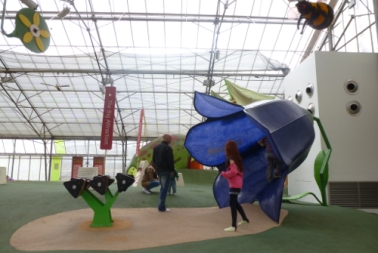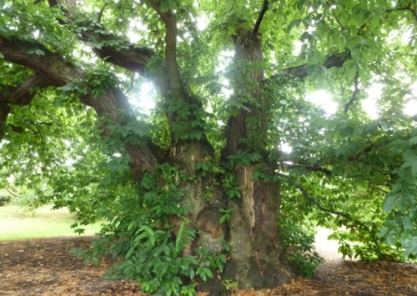You can learn all sorts of things from hanging out with plants.
Early in the London leg of my Europe trip, my friend Sarah took me to the Kew Royal Botanical Garden. An impressive oasis in the desert of city pavement, Kew maintains impeccably groomed, sprawling lawns, gardens, greenhouses, ponds, and forests.
It’s both peaceful and beautiful, a wonderful spot to go for a picnic or a decompression walk (if you have a year-long pass, in which case you avoid the pricey per-visit cost). Kids can love it too: the rainy day we went, Sarah’s daughter Zanna enjoyed the “Climbers and Creepers” indoor facility and then delighted even more in simply splashing through puddles.[1]
Given its royal heritage, the garden also has a touch of class. The tour guide trams gleam from cleaning, the bathrooms sparkle, and the food options provide healthy fare without draining the wallet. The locals who have access recognize the gem in their midst and make good use of the place.
The biological diversity of the flora at Kew impressed me even more. They had trees and plants literally from all over the world. Oaks, chestnuts, pines, maples, beech: you name it, Kew got it. Informative signs throughout the park clue visitors in to what they’re seeing and why it matters. Treetop walkways offer wide vistas. Careful greenhouses give close-up glimpses. I imagine a botanist could literally have a field day there, delightedly taking in the global range of possibilities without ever having to hop on a plane.
Curiously, even with all that to offer, I still found the place a bit…lifeless. Yes, Kew provided a wonderful counterbalance to the urban hubbub swirling around it, but it still seemed a bit of a clipped demonstration. The lawns and gardens catch the eye, but in controlled fashion, still distant or untouchable. The place is more a museum.
Remember, too, I had just come from Findhorn. There, the gardens grow in conscious, living partnership with the humans who “tend” them, sprawling out in celebration of the power and energy behind them. There, the shapes and patterns move organically, weaving and crossing walls and hand-carved fences.
The paths through the place curve and wend, emphasizing natural flow over efficient transport. It’s not all hodge-podge—there’s clear care that goes into the whimsy—but it is imprecise. And that imprecision makes for a warmer welcome.
At Kew, each member of a species often was the only one there, lacking fellow trees or grasses for company. The plants seemed resigned to their fate, soldiering on in lonely service to a colonial goal. At Findhorn, the gardens create a far more collective sense. Each time I wandered the place or sat on a bench to meditate, it felt like the flowers were happy to see me, not indifferent.
I realize I might be projecting to imagine the flowers as having human-like consciousness or emotion, to think that they might enjoy working in partnership with us. But their consciousness need not be human-like to be real. I might be picking up on a vitality that actually exists.
Either way, the differences between Kew and Findhorn offer another angle on how I’d like to work as a teacher. Tending to my students’ growth is a bit like working in a garden: our school spreads the soil they’ll grow in; I choose the texts and exercises that serve as rain and fertilizer; my care, warmth, and humor can provide some sunshine, and so on. Often, it feels the boarding school model matches the Kew’s. Keep a clean structure, trim the growth so it fits properly, and you’ll emerge with an impressive graduating class of notable diversity, worthy of a school’s royal name.
In my classroom (and I think at NMH, too), we shoot for something more organic. I want to work in partnership with the kids, helping them find their greatest expression, not mine created or designed for them. Our garden may get ragged at times, spilling forth unpredictably. At the same time, it will have a vitality and excitement that fosters even more learning. I like that surge of creativity. I want that improvisation.
[1] Her favorite (and my favorite) part of the visit may have been when we visited the pond in front of one of the greenhouses. Some other children were feeding pieces of bread to the ducks. In one instance when the ducks weren’t quite paying attention, a young lad threw a morsel onto the pond’s murky surface and a monstrously long and fat koi goldfish emerged from below to gobble it whole before disappearing again. It felt like a scene from Jaws, the thing was so huge. All the kids and adults gasped in awe.










As always, I enjoyed the post. I don’t know that I have anything fresh to add to the debate. My goal in posting today is just to say ‘thank you’ for the delicious pun!
Ah,you’re most welcome. You know there’s more where that came from. Actually, where the heck *do* puns come from?